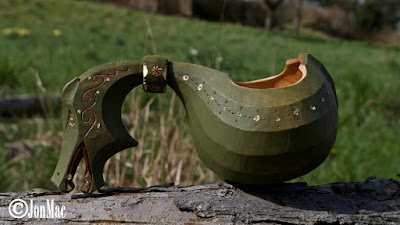I've been busy.
Just as well I have been using my new Adze as I was given a bit of a challenge from a friend of mine who is studying for her degree in archaeology.
A week or so ago she asked if I could help out with some living archaeology.
Lucy had been tasked by Professor Bradley to knap a flint adze and use it to make a wooden object.
Well, as promised, Lucy arrived at my home last week with a Hassochs flint adze she had made at Exeter university.
Lucy knapped a Bur flint adze head, wrapped it with a little piece of leather, and bound it, with raw hide, onto a piece of seasoned Silver Birch.
The flint head is described as uni-facial, whereby small flakes are removed at an acute angle with a hard hammer stone to reveal a strong, sharp working edge.
Little is known about the type of work for which this tool was used, as nothing much remains in the historical record.
We decided to experiment by hollowing out a short split billet of Birch. Whilst we were adzing away we discussed what might have been made with a tool such as this. Items came to mind as we worked.
Vessels for processing food, mortar and pestle, perhaps Kuksa, all sorts of things were discussed.
Apparently this type of tool pre-dates flint axe heads. It occurred to me that you could still fell a reasonably sized tree, by chopping round the tree beaver style.
Well I showed Lucy how to use the adze and set her on her way. With a lazy chopping action, being careful not to force the adze, it was surprising how efficient the flint was at removing waste wood.
The small curled shavings it removed were
not as clean or as large as a modern metal adze would produce, but it was surprising
how speedy the whole process was.
We cut from each end of the billet into the middle, and then cleaned up the collected curls of wood and started over.
We got a fair way into the bowl before I ran out of time for the day.
Lucy has taken the bowl back to the university so she can finish the job.
As you can see, the flint head is held on by a small pad of leather and a binding of pig raw hide.
We used the adze for two or three hours, I was quite surprised that the flint lost little of it's keen edge.
Lucy also bought me a gift made by professor Bruce Bradley.
It's a beautifully crafted adze head he knapped from a piece of green sand churt.
He has made it in the same style, uni-facial.
I will investigate as to what type of woods were available at the time these tools were in use, and select a good shaped helve onto which I can bind my flint head.
In the mean time I will carry on with my Gransfors Bruks gutter adze...
Once Lucy has finished her bowl I will ask her for some photographs for a future blog.
Enjoy...
J















Interesting. Recently I saw a neolithic adze, without the helve, in Portsmouth museum and had been wondering how it would have been used.
ReplyDeleteApparently the flint is often set the wrong way up. Worth checking out the next time you are in a museum. Cheers Rob...J
DeleteGreat pictures of a great day! I have taken a few for my report and will be sure to give you the credit and to reference you :D I will send you a copy once it is finished.
ReplyDeleteThanks again, Lucy :)
Hi hi Lucy. I look forward to seeing your finished bowl. Had a great afternoon...J;-)
DeleteI love the way that stone adze looks Jon. Really takes you back in time seeing it in use. In a world of power tools it is nice to see technology that is thousands of years old still working. Any chance you could knock up a quick video on carving spoon bowls using your GB adze?
ReplyDeleteHi hi Tom... It was strange at first to be honest, but the tool worked very well once it came to hand. As to making a video, I'll give it a shot sometime soon. Cheers Tom...J;-)
DeleteThe early peoples used what was available and we are proof of their success.
ReplyDeleteWe are lucky to have such innovative people in our history...J;-)
DeleteThat's so cool to see a stone tool at work! Our ancestors managed with 'limited' tools for a long time. It's all in the approach I guess.
ReplyDeleteYou are right Martijn. We worked carefully with measured accurate strokes and although the progress was slow, it worked...J
Deletelove this blog,have been visiting for some time,truly an ispiration are your works! also where could i get a roselli axe? i am using a gransfors wildlife hatchet but it seems a bit light for the job.
ReplyDeleteGlad you have had some fun with my blog, thanks for your comment... Here is a link to my tools page... I bought my Roselli direct some years ago...Cheers Strugglingfreeman... http://spooncarvingfirststeps.blogspot.com/p/beginners-tools-and-suppliers-details.html
DeleteThe Roselli is a great little axe...Enjoy...J
thanks jon,its on the top of my list of tools to get next to the gransfors gutter adze.....
ReplyDeleteJ:-)
Delete